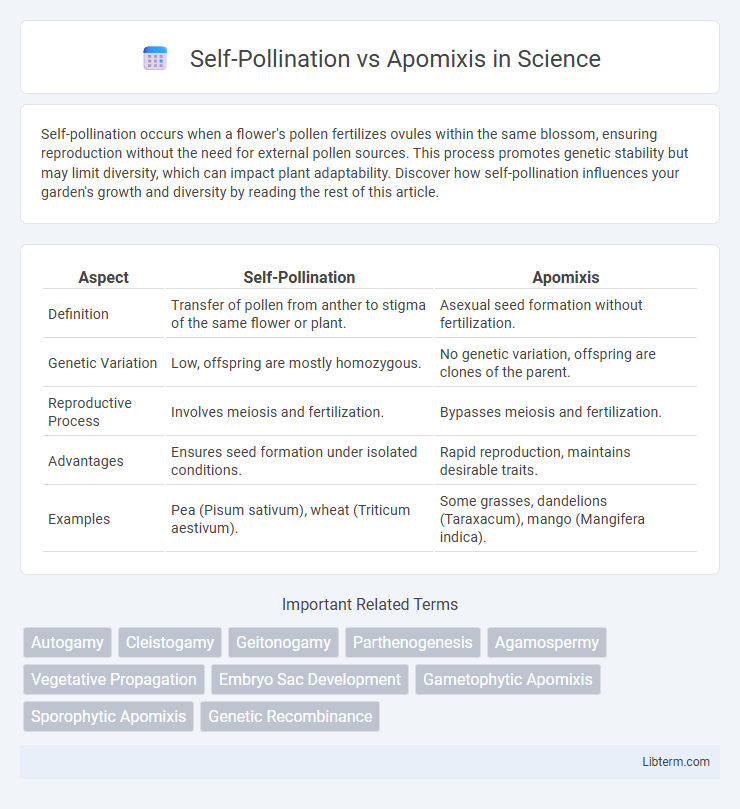Self-pollination occurs when a flower's pollen fertilizes ovules within the same blossom, ensuring reproduction without the need for external pollen sources. This process promotes genetic stability but may limit diversity, which can impact plant adaptability. Discover how self-pollination influences your garden's growth and diversity by reading the rest of this article.
Table of Comparison
| Aspect | Self-Pollination | Apomixis |
|---|---|---|
| Definition | Transfer of pollen from anther to stigma of the same flower or plant. | Asexual seed formation without fertilization. |
| Genetic Variation | Low, offspring are mostly homozygous. | No genetic variation, offspring are clones of the parent. |
| Reproductive Process | Involves meiosis and fertilization. | Bypasses meiosis and fertilization. |
| Advantages | Ensures seed formation under isolated conditions. | Rapid reproduction, maintains desirable traits. |
| Examples | Pea (Pisum sativum), wheat (Triticum aestivum). | Some grasses, dandelions (Taraxacum), mango (Mangifera indica). |
Introduction to Plant Reproductive Strategies
Self-pollination is a plant reproductive strategy where pollen from a flower fertilizes ovules of the same flower or another flower on the same plant, ensuring genetic consistency. Apomixis bypasses fertilization altogether by producing seeds asexually, allowing plants to reproduce clones without genetic variation. These strategies influence plant adaptation, survival, and agricultural breeding by balancing genetic stability and diversity.
Defining Self-Pollination
Self-pollination is the process where pollen from a flower's anther fertilizes the ovule of the same flower or another flower on the same plant, ensuring genetic continuity without external pollen sources. This reproductive strategy contrasts with apomixis, which bypasses fertilization entirely, producing offspring genetically identical to the parent through asexual seed formation. Understanding self-pollination is crucial for studying plant breeding systems and genetic diversity in crops.
Understanding Apomixis
Apomixis is a form of asexual reproduction in plants where seeds are produced without fertilization, leading to offspring genetically identical to the parent. Unlike self-pollination, which involves the transfer of pollen from the anther to the stigma of the same flower or plant, apomixis bypasses meiosis and fertilization entirely. This reproductive strategy ensures clonal propagation, maintaining desirable traits across generations and offering potential advantages in agriculture for uniform crop production.
Key Differences Between Self-Pollination and Apomixis
Self-pollination involves the transfer of pollen from the anther to the stigma within the same flower or plant, leading to fertilization and genetically similar offspring. Apomixis bypasses fertilization entirely, producing seeds through asexual reproduction and resulting in clones of the parent plant. Key differences include the reliance on fertilization in self-pollination versus the fertilization-free seed production in apomixis, and the resultant genetic variation in self-pollination compared to genetic uniformity in apomixis.
Genetic Implications: Self-Pollination vs Apomixis
Self-pollination results in offspring with a combination of genes from the same plant, leading to reduced genetic diversity and increased homozygosity, which may enhance the expression of both beneficial and deleterious traits. Apomixis produces genetically identical progeny through asexual reproduction, maintaining the exact genetic makeup of the parent and preserving advantageous genotypes across generations. Both mechanisms affect plant breeding and evolution differently, with self-pollination allowing limited genetic variation and apomixis ensuring clonal uniformity.
Examples of Self-Pollinating Plants
Self-pollination occurs in plants like wheat, rice, and peas, where pollen from the same flower fertilizes the ovule, ensuring genetic consistency. Apomixis, found in species such as dandelions and certain grasses, enables asexual seed formation without fertilization, producing genetically identical offspring. These reproductive strategies reflect adaptations that influence plant breeding, genetic diversity, and crop yield stability.
Apomictic Species in Nature
Apomictic species reproduce through asexual seed formation, bypassing fertilization and maintaining genetic uniformity across generations. This reproductive strategy is common in plants such as dandelions (Taraxacum spp.) and certain grasses, enabling rapid colonization in stable environments. Apomixis provides evolutionary advantages by preserving advantageous genotypes while allowing adaptation to diverse ecological niches without genetic recombination.
Advantages and Disadvantages of Self-Pollination
Self-pollination ensures genetic stability by allowing plants to reproduce without the need for external pollen, which promotes uniformity and preserves desirable traits in crops. However, it limits genetic diversity, increasing susceptibility to diseases and reducing adaptability to changing environments. Compared to apomixis, which produces clonal offspring without fertilization, self-pollination still involves meiosis and potential genetic recombination, maintaining some level of variability.
Benefits and Limitations of Apomixis
Apomixis offers the benefit of producing genetically uniform offspring without fertilization, ensuring trait stability and rapid propagation of desirable plants. This asexual reproduction method eliminates the need for pollinators and reduces genetic variability, which can limit adaptability to environmental changes. However, the lack of genetic diversity in apomictic populations can increase vulnerability to diseases and limit long-term evolutionary potential.
Agricultural and Ecological Impact of Reproductive Modes
Self-pollination ensures genetic uniformity and stability in crop plants, promoting consistent yield and quality, which is crucial for large-scale agriculture. Apomixis produces clonal seeds without fertilization, enabling the fixation of hybrid vigor and reducing the need for repeated hybrid seed production, thus lowering seed costs. Ecologically, self-pollination may limit genetic diversity and adaptability, while apomixis supports population persistence in stable environments but could reduce genetic variation essential for long-term resilience.
Self-Pollination Infographic

 libterm.com
libterm.com